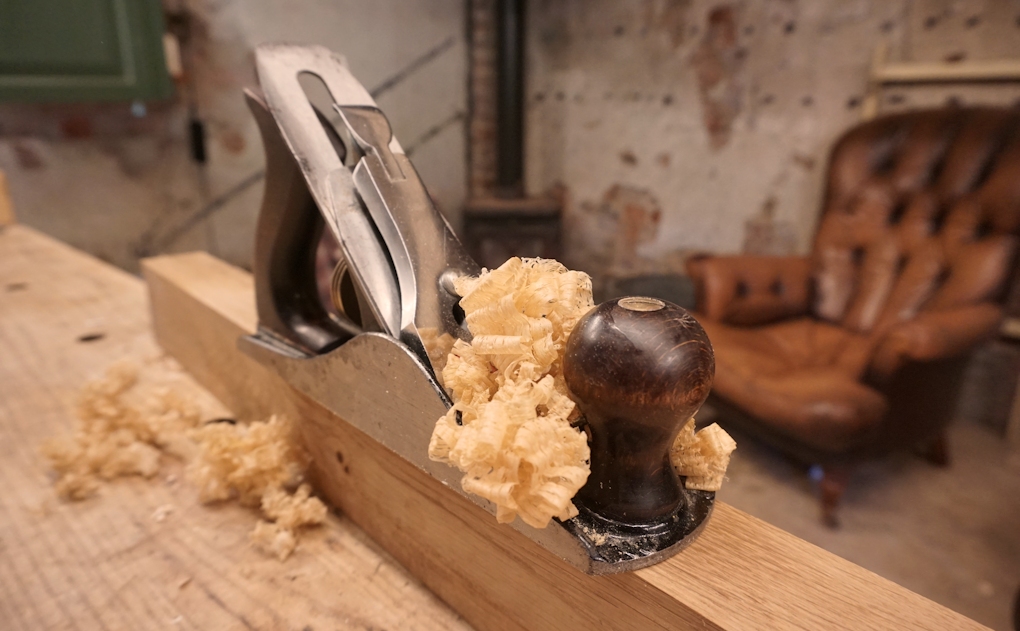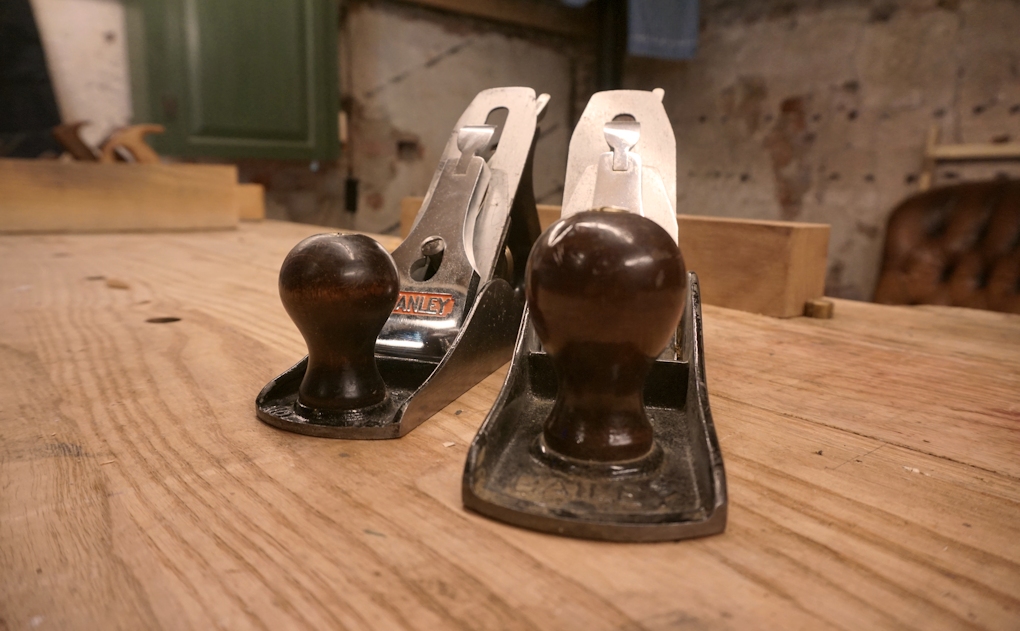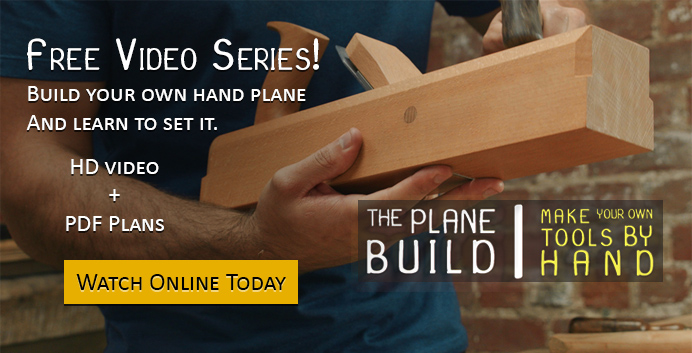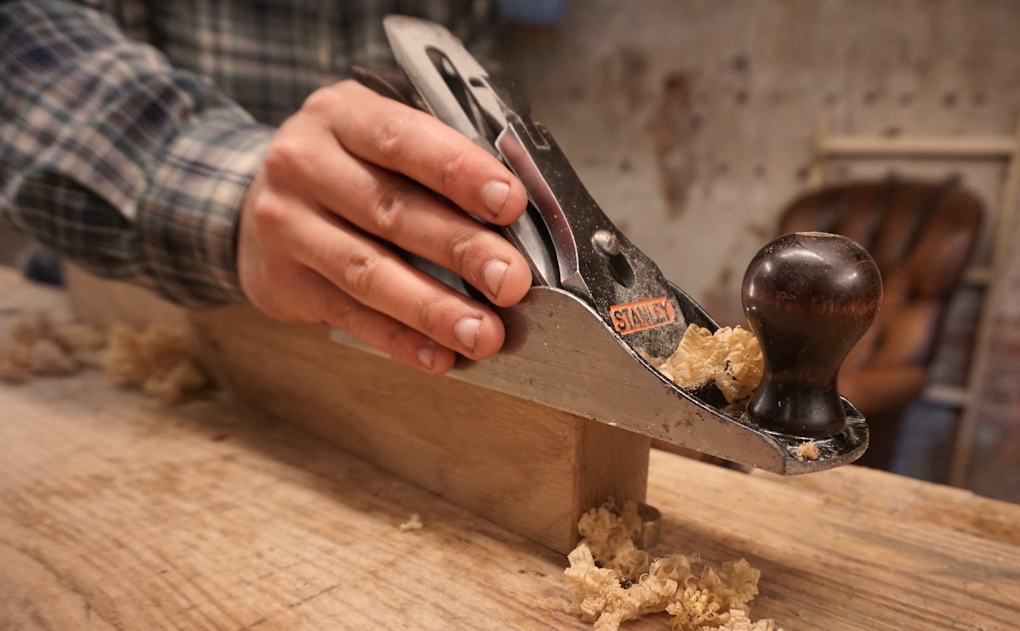In one of the recent videos I was whining on about the jack plane, and how feel that the No 5 is the best all round, multi use bench plane.
In another video I’ve also mentioned my love for a nice small smoothing plane, so I thought it’d be worth going through some of my reasons.
Setting Up With Hand Planes
Strategic Tool Buying
For beginners I’ve noticed that one of the big questions when buying tools is should I go new or old. The thing that bugs me about the all old option, is that whilst you get the tools cheap, you need to buy more tools and kit, for the refurbing. However if you buy strategically you don’t have to spend a fortune, or dare I say a penny.
The jack plane I’ve covered here; just tune up, get an edge on the blade, done and dusted.
The jointer plane needs a perfectly straight sole, though it doesn’t necessarily need to be flat. You won’t need this plane straight away though, so put it on the back burner and we’ll come back to it.

The smoothing plane takes fine shavings to remove any rough areas and leave the wood surface smooth. This is used after the wood has been dimensioned, as you won’t be removing much material.
Setting Up Your First Smoothing Plane
The Finest Plane Of Them All
The smoothing plane – this is where you need to put your efforts in setting up. It’s the last plane used on your work, so unlike the jack, it can’t look like it’s been up a troll’s arse. Or rather whilst it doesn’t need to look fine, it needs to be fine. This is where you need your perfection.
When I did my rant about your first hand plane, the question was one plane, and in that instance I had just a jack with two blades. The second iron makes the plane capable of both rough and smooth work, along with jointing.
That’s where I’d start, and if I had to have only one plane it’s also where I’d stay. But if I’m going to expand my collection and get a dedicated smoothing plane then I want it to be exceptional.
If you’re looking for a dedicated smoother (we’ll just talk about metal planes here for ease) then my recommendation is to consider a No. 3 size.
By comparison this makes the No.4, and particularly the 4 1/2 feel like an engineering brick, since it is both shorter and narrower.
You don’t need an arsenal of tools, but with a small selection it’s worth ensuring that each is optimised to suit its task. Having a small smoothing plane is tremendously beneficial. You’ll be able to finish the surface beautifully whilst removing as little material as possible, because it won’t be making any attempt to flatten.

The Smoothing Plane In Use
As the user we control the surface finish created just as much as the tool itself. Whilst a sharp iron and well set plane can create whisper thin shavings, when our strokes are consistent we achieve a smoother result.
The second we come against the grain, more resistance is created and there’s a change in pace of our shaving. This all encourages a shoddy finish. This may be nominal, but on a fine finish it’s notable.
The narrow blade of the No. 3 hand plane gives you great strength behind each shaving, so you can push through any grain with consistency.
In other words; the finest smoothing plane with the sharpest of edges being pushed by the jitteriest of arm will give the finish of the arm.

A small smoothing plane is fast and cheap to restore as the sole can be flatten on a sharpening stone
Small Plane = Fast & Cheap Restoration
For tarting up your used smoothing plane you’ll need to take extra lengths than with the jack or any roughing tool.
The beauty with the No. 3 is it’s small, so you won’t need to splash out. I’ve just helped Helen flatten the sole of hers on a sharpening stone, no need for a snazzy expensive flat plate. And if you’ve got diamond stones then this will be the fastest sole flatten of your life!
Overall the areas to focus on along with the flat sole, are making sure that the back of the iron is flat, and I also give the cap iron a lot of work.
Set Up Your Cap Irons To Defeat Tear Out, & Turn Even A Cheap Plane Into An Exceptional Smoother.
This is the only plane that I will worry about either the sole or the cap iron, if there’s a cap iron on a jack I’ll usually back it up out of the way instead, since I find it more of a hindrance.
I do no work on the frog; this is also touched on in the next rant.
Get the iron nice and sharp and you should be good to go.
We all have different approaches with these things.
I know that many would seek true flatness on every iron and every plane and there’s a lot of sense in that. I’ve always preferred choosing the optimum size and set up for the task in mind, this is what I do in my work and manage to put food on the table, so I’m not going to complain at that.
If you have big hands and struggle to hold a No. 3 then you need to grab it like your straggling someone, that works for me. You’re already sticking one finger off the handle on a normal plane, so just do the same with another.



![How I Sharpen My Chisels. [Video]](https://www.theenglishwoodworker.com/wp-content/uploads/2025/08/How-I-sharpen-my-chisels-400x250.jpg)
![Which Saws Are Best For Ripping Thick Stuff? [Video]](https://www.theenglishwoodworker.com/wp-content/uploads/2022/12/what-hand-saw-is-best-for-thick-rip-cuts.jpg)
![How do I Sharpen a Router Plane? [Q & A Video]](https://www.theenglishwoodworker.com/wp-content/uploads/2022/11/how-to-sharpen-a-router-plane-video.jpg)
![Bench Top Edge Jointing [with Video]](https://www.theenglishwoodworker.com/wp-content/uploads/2022/10/bench-top-edge-jointing-video.jpg)
Thanks Richard, another great article buddy. 😉
Hi Richard,
interesting post. Small planes seems to be the new trend. Good that I have started my woodworking journey with a #3. Haven’t touched it for years. Maybe I’ll grab it next time in the shop.
Cheers,
Stefan
I find that grabbing my tools like I’m strangling someone always helps. Have to show them who’s boss.
It’s interesting that more and more people seem to be discovering/rediscovering the #3. There for awhile all I read was “bigger is better and Bedrock is best.” There seems to be a sea-change in the wind.
Hi Derek, I never understood the bigger is best thing for smoothing, maybe that’s because I’ve come from a wooden plane background. I have what seems like a huge coffin smoother and yet it’s still shorter than a No. 3.
Very interesting about the No3 being easier to push through the planning stroke, I use a 4 1/2 as I find that ,being heavy, has more momentum and carries me through twisty Oak grain without a stop, but when planning Pine or Poplar the lighter plane would probably be less tireing , I will have to tune up my No 3 and try it on some Poplar I have to use shortly, I also find the very thin iron that these planes come with as standard make it very difficult to take a consistent shaving.
Hi Chris, there’s definitely two minds when it comes to preference on weight of a plane. When I used my first infill plane (only last year!) I was surprised at how light it felt in use, despite its weight. I like the speed of a light weight plane personally for daily using, I suppose it’s what I’m used to, and as for ease of stroke I do find that the narrower shavings are a good advantage for control, particularly since the irons are so thin in these, as you say.
Well, looks like I’d better find a decent used No3 before they are all almost as expensive as brand new
Don’t worry Joe… I can’t imagine anyone actually listens to me drear on 😉
Excellent Richard – I’m a fan of the No3 as a day-to-day smoother although my grip needed changing too as my knuckles knock the depth adjust a bit. One to consider (may I say) is the Record especially the SS 2-part cap… an under-rated cracker with the crucible iron. Don’t care if they go up a bit, got mine 🙂
Thanks Douglas, other brands are available 😉
I completely agree and I know that the Record’s have their own little fan club. I’m one of these that anything will do which normally means that I end up with a run of the mill Stanley.
I am unsure why it is that a No 3 is what I first grab to trim end grain. I grab it before the block plane. It seems better more often then not. I only seem to use the block plane if I cannot get at it with the No 3.
Hey guys,
I like the idea of the #3 being easier to push and I agree with Richard that an inconsistent stroke will produce less than perfect results. I have huge grizzly hands and using a #4 has always caused discomfort. I went to my shop after reading this and gripped my #4 with the chokehold move and a lightbulb went off. Thanks!
Jesus wept! Between reading you, Paul Sellers and Christopher Schwarz I’m slowly losing my mind. Nurse! My pills. Lol.
Very interesting post Richard. I have a Sargent 407 (equivalent to Stanley No 2) that is in a well battered condition. I don’t use it as the blade has been softened at some time, when being ground I suspect, and won’t hold an edge. I have been thinking of selling it, but as both totes have been replaced and the front one looks like a modified cotton reel, no collector will want it. Maybe I should re-harden the blade and give it another go?
Hey Richard,
Great article sir! I don’t own a 4 or 4 1/2 for all the reasons that you and Chris S. have detailed. I have a metal #3-sized smoother and a few woodies that I’ve made that are in the #2-3 size range.
Keep up the great writing and videos…
Vic
Some of my Stanley planes were my grandfather’s (pre-1930) and my #7 belonged to my great-grandfather. A couple of years ago I tuned up Grandpa’s #3 that I’d thought just a tiny and quaint shop paperweight. Once it was running well, it quickly became a tool I reach for often. Are we going to create a #3 feeding frenzy on Ebay? Good that I already have mine!
I love my number 3. Much more comfortable than my number 4, which I probably should sell as I really don’t use it as much (at all) since the aquisition of the 3. I keep hoping the 4 will magically feel good in my hand again, but the 3 has pretty much insured that won’t happen.
A bit surprised at your comment on the flatness of diamond stones. An Atoma I bought many years ago, as my first diamond stone, turned out to be convex, a Trend I bought more recently has hollowed after several years use, and the cheaper 2 sided Axminster, bought a couple of years ago, has followed suit. I like no.3s, and now have three, 2 Records and an Acorn. Not sure why but they just seem to suit. I have replaced the original blades in the first two with a Clifton (I don’t think they make the 3 blade any more) and an Iles. I generally prefer the Clifton blades, but the Iles is/was a great deal cheaper.
As far as diamond stones are concerned, check for flatness before you buy. Just because it’s new, it won’t necessarily be flat.
Mike
Thanks Mike, I was referring to the cutting speed of diamond stones and not really the flatness. Mine aren’t perfectly flat but they’re within my tolerances. Great advice with regards to buying them, it’s definitely something which you shouldn’t assume will be right.
Three number threes… why not!
Based on this I tracked down and purchased an older Stanley # 3 on ebay. I received it day before yesterday and was actually surprised how small it is. Tiny actually. Although the blade was sharp I gave it a touch and gave it a test drive.
I did not do too well but with practice it will be get much better. Thanks for the tip.
My initial kit when I started in with hand tools was a stanley #3 and a stanley #5. The 3 was a hand-me-down from my father. The #5 was a typical ebay purchase. In my experience I can do everything I need to do with those two planes. Over the last few years, I’ve picked up some additional metal planes, but this was mostly just for sport and fun. A #4 I added to the mix has become a favorite along with the original two. I can honestly say, though, that the original #3 and #5 are all I strictly need. Of course, it would be impossible to assert this if I hadn’t actually picked up the other planes and used them as well.. And there isn’t anything wrong with my subsequent purchases, they just turned out to not be essential with respect to my needs. So if you enjoy dicking about with old hand planes and have the time for it, I do think it can be interesting, instructive, and even fun to pick up a few from online or other places. I have a few records, a few stanley’s and a few other brands. Having played around with all these, I can say, for example, that every plane is a bit different- even planes of the same model from the same manufacturer. So even two stanley #4’s end up feeling a bit different. Each seems to develop it’s own personality as you tune it and use it. Like I noted earlier, one of the stanley #4’s just seemed to feel really nice to me. I’ve also discovered that I don’t like 4 1/2’s for many things. There are plenty of people that seem to love them, but for me, the extra width just seems to make it harder to use effectively (for me). On rare occasions, though, that little extra bit of width can be super helpful. In sum, I totally agree with the content Richard presented. One more interesting thing I’ve discovered is that it is useful to circle back to articles like this one (and others out there on the inter webs) every so often. Every time I come back to content like this, I pick up things I missed earlier in my evolution as wood worker. I think this is because there are things that only click and make sense after you’ve reached a certain point in your learning curve.